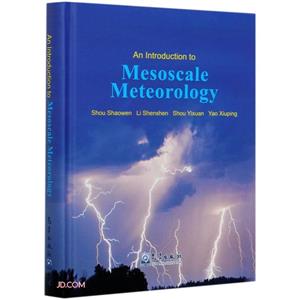掃一掃
關(guān)注中圖網(wǎng)
官方微博
本類五星書更多>
-
>
宇宙、量子和人類心靈
-
>
氣候文明史
-
>
南極100天
-
>
考研數(shù)學(xué)專題練1200題
-
>
希格斯:“上帝粒子”的發(fā)明與發(fā)現(xiàn)
-
>
神農(nóng)架疊層石:10多億年前遠(yuǎn)古海洋微生物建造的大堡礁
-
>
聲音簡(jiǎn)史
中圖價(jià):¥82.5
加入購(gòu)物車
An introduction to mesoscale meteorology 版權(quán)信息
- ISBN:9787502972899
- 條形碼:9787502972899 ; 978-7-5029-7289-9
- 裝幀:一般膠版紙
- 冊(cè)數(shù):暫無(wú)
- 重量:暫無(wú)
- 所屬分類:>
An introduction to mesoscale meteorology 內(nèi)容簡(jiǎn)介
本書內(nèi)容包括: 中尺度大氣運(yùn)動(dòng)的特征 ; 地形性中尺度環(huán)流 ; 自由大氣重力波 ; 鋒和急流, 中尺度對(duì)流系統(tǒng) ; 大氣不穩(wěn)定性 ; 影響中尺度對(duì)流系統(tǒng)發(fā)生發(fā)展的因子 ; 中尺度天氣的診斷和預(yù)報(bào)。
An introduction to mesoscale meteorology 目錄
Preface
Chapter 1 Features and Equation Set of Mesoscale Atomospheric Motions
1.1 The scale division of atmospheric motion systems
1.2 Basic features of mesoscale atmospheric motions
1.3 Equations set for describing mesoscale motions
References
Chapter 2 Topographically Forced Mesoscale Circulations
2.1 Topographic waves
2.2 Circulations in wake
2.3 Urban heat island circulation
2.4 Sea-land breeze
2.5 Mountain and valley breeze
References
Chapter 3 Gravity Waves in Free Atmosphere
3.1 Basic features of gravity waves
3.2 Dynamic features of gravity waves
3.3 Structure and influences of gravity waves
3.4 Development of gravity waves
3.5 Development of the gravity waves near the upper level jet streak
References
Chapter 4 Front and Jet Stream
4.1 Structure of the front
4.2 Kinematic and thermodynamic frontogenesis
4.3 Dynamic frontogenesis
4.4 The factors influencing frontogenesis
4.5 Frontal lateral secondary circulation
4.6 Jet stream
4.7 Mesoscale fronts in boundary layer
References
Chapter 5 Mesoscale Convective Systems
5.1 Isolated convective systems
5.2 Belt-shaped convective systems
5.3 Mesoscale convective complex (MCC)
References
Chapter 6 Atmospheric Instabilities
6.1 Conditional instability
6.2 Conditional instability of second kind (CISK)
6.3 Wave-CISK
6.4 Inertial instability
6.5 Conditional symmetric instability
6.6 Kelvin-Helmholtz instability
References
Chapter 7 Factors Effecting the Development of MCSs
7.1 The relationship between the atmospheric potential instability and convection
7.2 The factors influencing on convective clouds
7.3 The effect of the vertical wind shear on propagation of convective storm
7.4 The comprehensive effect of the environmental thermal and dynamic conditions on the intensity and types of the convective storms
7.5 The effect of the vertical wind shear on the organization and splitting of the storms
7.6 The effect of the vertical wind shear on formation of tornado storms
References
Chapter 8 Mesoscale Weather Diagnosis Analysis
8.1 co equation
8.2 Analysis of Q vector
8.3 Analysis of potential vorticity
8.4 Analysis of the helicity
8.5 Analysis of the atmospheric instability
8.6 Some case studies of the severe weather
References
Chapter 9 Mesoseale Weather Forecasting
9.1 Methodology of mesoscale weather forecasting
9.2 Diagnosis and forecasting of heavy rain
9.3 Analysis and forecasting of the severe convective weather
9.4 Data and tools applied in nowcasting and VSRF
References
Chapter 1 Features and Equation Set of Mesoscale Atomospheric Motions
1.1 The scale division of atmospheric motion systems
1.2 Basic features of mesoscale atmospheric motions
1.3 Equations set for describing mesoscale motions
References
Chapter 2 Topographically Forced Mesoscale Circulations
2.1 Topographic waves
2.2 Circulations in wake
2.3 Urban heat island circulation
2.4 Sea-land breeze
2.5 Mountain and valley breeze
References
Chapter 3 Gravity Waves in Free Atmosphere
3.1 Basic features of gravity waves
3.2 Dynamic features of gravity waves
3.3 Structure and influences of gravity waves
3.4 Development of gravity waves
3.5 Development of the gravity waves near the upper level jet streak
References
Chapter 4 Front and Jet Stream
4.1 Structure of the front
4.2 Kinematic and thermodynamic frontogenesis
4.3 Dynamic frontogenesis
4.4 The factors influencing frontogenesis
4.5 Frontal lateral secondary circulation
4.6 Jet stream
4.7 Mesoscale fronts in boundary layer
References
Chapter 5 Mesoscale Convective Systems
5.1 Isolated convective systems
5.2 Belt-shaped convective systems
5.3 Mesoscale convective complex (MCC)
References
Chapter 6 Atmospheric Instabilities
6.1 Conditional instability
6.2 Conditional instability of second kind (CISK)
6.3 Wave-CISK
6.4 Inertial instability
6.5 Conditional symmetric instability
6.6 Kelvin-Helmholtz instability
References
Chapter 7 Factors Effecting the Development of MCSs
7.1 The relationship between the atmospheric potential instability and convection
7.2 The factors influencing on convective clouds
7.3 The effect of the vertical wind shear on propagation of convective storm
7.4 The comprehensive effect of the environmental thermal and dynamic conditions on the intensity and types of the convective storms
7.5 The effect of the vertical wind shear on the organization and splitting of the storms
7.6 The effect of the vertical wind shear on formation of tornado storms
References
Chapter 8 Mesoscale Weather Diagnosis Analysis
8.1 co equation
8.2 Analysis of Q vector
8.3 Analysis of potential vorticity
8.4 Analysis of the helicity
8.5 Analysis of the atmospheric instability
8.6 Some case studies of the severe weather
References
Chapter 9 Mesoseale Weather Forecasting
9.1 Methodology of mesoscale weather forecasting
9.2 Diagnosis and forecasting of heavy rain
9.3 Analysis and forecasting of the severe convective weather
9.4 Data and tools applied in nowcasting and VSRF
References
展開全部
書友推薦
- >
中國(guó)人在烏蘇里邊疆區(qū):歷史與人類學(xué)概述
- >
上帝之肋:男人的真實(shí)旅程
- >
巴金-再思錄
- >
煙與鏡
- >
朝聞道
- >
二體千字文
- >
中國(guó)歷史的瞬間
- >
企鵝口袋書系列·偉大的思想20:論自然選擇(英漢雙語(yǔ))
本類暢銷
















